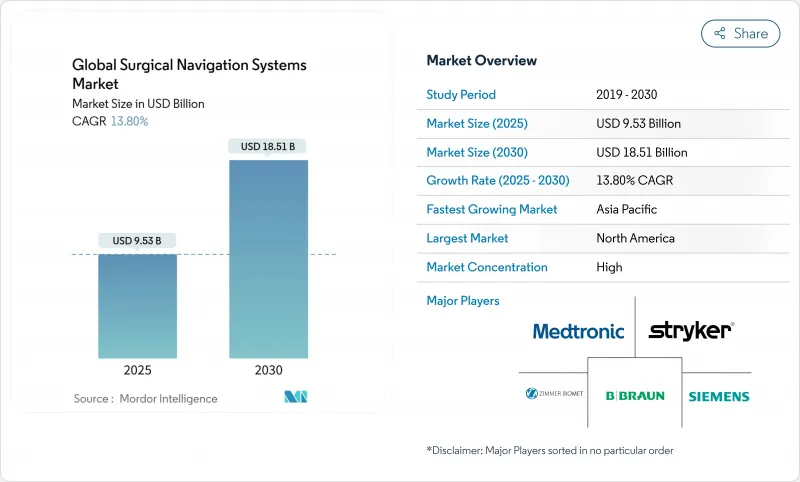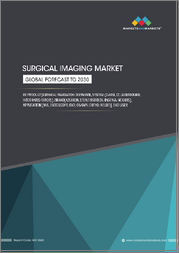
|
시장보고서
상품코드
1842574
세계의 수술용 내비게이션 시스템 시장 : 시장 점유율 분석, 산업 동향, 통계, 성장 예측(2025-2030년)Global Surgical Navigation Systems - Market Share Analysis, Industry Trends & Statistics, Growth Forecasts (2025 - 2030) |
||||||
세계의 수술용 네비게이션 시스템 시장의 규모는 2025년 95억 3,000만 달러에 이를 전망으로, 2030년에는 185억 1,000만 달러에 이를 것으로 예상되며 CAGR 13.8%로 성장하고 있습니다.

이러한 성장은 재수술률을 줄이고 환자의 회복 기간을 단축하는 정밀 가이드가 있는 저침습 수술로의 전환이 확산되고 있음을 반영합니다. 척추, 신경외과, 정형외과의 경우에 임상적 복잡성이 증가함에 따라 병원을 영상 유도 기술에 투자하는 데 도움이 되며, 인공지능 대응 계획 도구는 수술 시간을 단축하고 임플란트의 위치 결정 정확도를 향상시킵니다. 보다 광범위한 환급 범위와 일괄 지불 모델은 결과 향상을 입증한 공급자에게 보상을 주고 채택을 더욱 향상시킵니다. 아시아태평양에서는 인프라가 급속히 확대되고 하이브리드 수술실에 연결되는 커넥티드 플랫폼에 대한 새로운 수요가 탄생하고 있습니다. 벤더는 3D 이미지와 머신러닝 알고리즘을 융합시켜 차별화를 도모하고 있지만, 사이버 보안 규칙이나 숙련된 기술자의 부족으로 보급이 지연될 수도 있습니다.
세계의 수술용 네비게이션 시스템 시장의 동향과 인사이트
복잡한 수술 사례 증가
복잡한 척추 변형 수술의 84%는 현재 네비게이션에 의존하고 있으며, 투시 하에서 50-80%에 대해 등급 A의 스크류 정밀도를 달성하여 사례 당 평균 33,939달러의 재수술 비용을 절감하고 있습니다. 다질환이 특징인 고령화에 의해 증례 수가 증가하고 있기 때문에 의료 제공업체는 정밀한 지침을 합병증 발병률의 저하나 입원 기간의 단축으로 연결함으로써 설비 투자를 정당화하고 있습니다. 이로 인해 예산이 까다로운 환경에서도 수요는 증가하여 수술용 내비게이션 시스템 시장을 강화하고 있습니다. 긴 임상 실적을 가진 벤더는 외과 의사의 신뢰를 더욱 획득하여 대규모 센터에서의 갱신 사이클을 가속화하고 있습니다.
저침습 수술과 로봇 수술 채용 증가
로봇 지원에 의한 인공 슬관절 전치환술은 이미 미국 수술 건수의 13%를 차지하고 있으며, 네비게이션은 정확한 뼈 절제와 임플란트의 정렬에 필수적입니다. 외과의사는 일반적으로 12-17례의 로봇 수술로 숙련되기 때문에 학습 곡선의 장벽이 낮아집니다. 외래 시설은 2011년과 2018년 사이에 287억 달러의 절약을 가져온 외래 설정에 유리한 메디케어 비율로 지원되어 이러한 절차를 채용합니다. 이 마이그레이션은 정밀도구가 안전한 저침습 접근에 필수적이 됨에 따라 수술용 네비게이션 시스템 시장에서 수년간의 성장을 보장합니다.
높은 설비 투자와 수명 주기 비용 필요
네비게이션이 있는 O-arm 구매는 4년 동안 589,205달러의 비용이 들 수 있으며, 척추 외과의의 77%가 가격을 가장 큰 채택 장벽으로 꼽았습니다. 그러나 소규모 병원과 신흥 시장의 의료 제공업체들은 여전히 고전을 겪고 있습니다. 고액의 재수술을 피할 수 있는 대량 가동 센터에서는 경제 모델에 의해 긍정적 효과가 나타나는 것이 증명되고 있지만, 비용에 대한 불안이 최초 도입의 상한을 결정할 가능성이 있습니다. 벤더는 모듈식 업그레이드를 도입하여 지출 곡선을 평탄화하고 수술용 네비게이션 시스템 시장의 성장을 유지하는 것을 목표로 하고 있습니다.
부문 분석
전자기 플랫폼은 시선이 차단되는 해부학적 구조에서 그 성능이 입증되었기 때문에 2024년에는 수술용 내비게이션 시스템 시장 점유율의 41.9%를 차지했습니다. 병원은 번거로운 반사경 없이 연조직을 통해 기구를 추적할 수 있는 능력을 높이 평가합니다. 그러나 광학 솔루션이 성장하고 있으며 고속 카메라와 AI 기반 마커리스 추적에 도움이 되어 CAGR 8.3%로 성장을 지속하고 있습니다. 이 부문의 상승은 수술실에서 혼잡한 수술 분야에서의 신속한 설정과 드리프트 에러의 감소를 중시하고 추적 모드를 전환할 수 있는 듀얼 모달리티 스위트로 시설이 이동하고 있는 것을 밝혀냈습니다.
하이브리드 구성에서는 코일과 카메라가 통합된 카트에 수납되며, 외과의사는 수술 도중에 양식을 전환할 수 있습니다. 형광 투시 및 CT 기반 네비게이션은 외상과 복잡한 척추에서 틈새 수요를 보장하지만 방사선 노출 문제에 직면하고 있습니다. 증강현실(AR) 헤드셋과 MRI 적응 전자기 프로브와 같은 신흥 모달리티는 '기타' 버킷에 위치하며 가격과 규제 경로가 성숙하면 단계적인 변화를 가져올 것으로 기대됩니다. 이러한 혁신은 수술용 내비게이션 시스템 시장의 장기적인 확장을 유지하는 데 도움이 됩니다.
지역 분석
북미는 2024년 매출의 38.2%를 차지하였으며 강력한 환급, 하이브리드 OR의 보급, AI 모듈의 조기 도입에 의해 뒷받침되고 있습니다. 미국은 척추 및 뇌 수술에서 정위 네비게이션으로 환급되는 CPT 패스웨이에 의해 지원되며 지역 성장을 이끌고 있습니다. 멕시코에서는 국경을 넘은 장비 공급 협정이 맺어져 하이 엔드 콘솔이 민간 병원에서도 입수하기 쉬워지고 있습니다. 그럼에도 불구하고 대도시 중심부에서는 포화 상태에 있기 때문에 북미의 수술용 내비게이션 시스템 시장은 최초 구입보다 교체로 전환하고 있으며, 제조업체 각사는 정밀도 향상보다 워크플로우나 사이버 보안 업그레이드에 중점을 두고 있습니다.
아시아태평양은 2030년까지 연평균 복합 성장률(CAGR)이 8.0%로 가장 급성장하고 있는 지역입니다. 중국은 국내 뉴로봇 프로그램을 우선시하고 있으며, 국가의료제품관리국의 개혁에 의해 혁신적인 플랫폼의 승인시간이 단축되어 국내외에서의 진입을 촉구하고 있습니다. 일본과 한국은 견고한 일렉트로닉스 공급 체인을 활용하여 OEM 제휴를 가속화하고 인도에서는 급성장하는 의료 관광 클러스터가 비용 효율적이면서 선진적인 네비게이션 콘솔을 요구하고 있습니다.
유럽은 다층적인 환급 제도와 CE 마크 취득 일정에 따라 성장이 꾸준하지만 변동이 있습니다. 독일과 프랑스는 병원 예산과 외과 의사의 로비 활동에 의해 조기에 도입되었지만, 이탈리아와 스페인에서는 DRG 시스템에서 관세의 모호함으로 조달이 지연되고 있습니다. 국경을 넘어서는 연구 컨소시엄이 혁신의 활력을 유지하는 한편, EU의 AI법은 디지털 건강 기준을 조화시켜 지역 전체의 발매를 용이하게 할 가능성이 있습니다. 중동 및 아프리카에서는 GCC 국가와 남미에서의 지출 급증이 벤더에게 새로운 길을 제시하고, 라틴아메리카의 매크로 변동은 브라질의 사설망 이외의 단기적인 도입을 억제합니다. 예측 기간 동안 이러한 요인이 혼합되어 수술용 네비게이션 시스템 시장의 장기적인 확대가 예상됩니다.
기타 혜택
- 엑셀 형식 시장 예측(ME) 시트
- 3개월의 애널리스트 서포트
목차
제1장 도입
- 조사의 전제조건과 시장 정의
- 조사 범위
제2장 조사 방법
제3장 주요 요약
제4장 시장 상황
- 시장 개요
- 시장 성장 촉진요인
- 복잡한 수술 증례 증가
- 저침습 수술과 로봇 수술의 채용 증가
- 3D 이미징과 AI 알고리즘의 지속적인 혁신
- 첨단 OR 기술에 대한 폭넓은 환급과 자금 조달
- 신흥 헬스케어 시장에서의 인프라의 급속한 확대
- 네비게이션 플랫폼과 하이브리드 수술실의 통합
- 시장 성장 억제요인
- 높은 설비 투자와 라이프사이클 비용
- 여러 지역의 규제 당국에 의한 승인 프로세스의 장기화
- 숙련된 임상의 및 기술자의 부족
- 사이버 보안 및 데이터 프라이버시에 대한 우려 증가
- 공급망 분석
- 규제 상황
- 기술적 전망
- Porter's Five Forces 분석
- 신규 참가업체의 위협
- 구매자의 협상력
- 공급기업의 협상력
- 대체품의 위협
- 경쟁 기업간 경쟁 관계
제5장 시장 규모 및 성장 예측
- 기술별
- 전자기 내비게이션 시스템
- 광학 네비게이션 시스템
- 하이브리드 시스템
- 투시 기반 시스템
- CT 기반 시스템
- 기타
- 용도별
- 뇌신경외과
- 정형외과 및 외상외과
- 척추외과
- 이비인후과
- 심장 및 흉부 수술
- 치과 및 턱 안면 외과
- 최종 사용자별
- 병원
- 외래수술센터(ASC)
- 기타
- 지역별
- 북미
- 미국
- 캐나다
- 멕시코
- 유럽
- 독일
- 영국
- 프랑스
- 이탈리아
- 스페인
- 기타 유럽
- 아시아태평양
- 중국
- 일본
- 인도
- 한국
- 호주
- 기타 아시아태평양
- 중동 및 아프리카
- GCC
- 남아프리카
- 기타 중동 및 아프리카
- 남미
- 브라질
- 아르헨티나
- 기타 남미
- 북미
제6장 경쟁 구도
- 시장 집중도
- 시장 점유율 분석
- 기업 프로파일
- Medtronic plc
- Stryker Corporation
- Brainlab AG
- Siemens Healthineers
- Zimmer Biomet Holdings
- B. Braun(Aesculap)
- KARL STORZ SE
- Fiagon GmbH
- DePuy Synthes(J&J)
- CAScination AG
- Intuitive Surgical
- Smith & Nephew
- Globus Medical
- GE Healthcare
- Royal Philips
- Accuray Inc.
- Surgalign Holdings
- Scopis GmbH(Stryker)
- Synaptive Medical
- Elvation Medical
제7장 시장 기회와 전망
CSM 25.11.03The surgical navigation systems market size stands at USD 9.53 billion in 2025 and is forecast to reach USD 18.51 billion by 2030, advancing at a 13.8% CAGR.

The acceleration reflects widespread migration toward precision-guided, minimally invasive procedures that cut revision rates and shorten patient recovery timelines. Higher clinical complexity in spine, neurosurgery, and orthopedic cases pushes hospitals to invest in image-guided technologies, while AI-enabled planning tools shrink operative time and improve implant positioning accuracy. Broader reimbursement coverage and bundled-payment models reward providers that demonstrate outcome gains, further lifting adoption. Rapid infrastructure expansion across Asia Pacific creates fresh demand for connected platforms that slot into hybrid operating rooms. Vendors differentiate by fusing 3D imaging with machine-learning algorithms, but must also navigate cybersecurity rules and a shortage of trained technicians that could slow roll-outs.
Global Surgical Navigation Systems Market Trends and Insights
Increasing Prevalence of Complex Surgical Cases
Eighty-four percent of complex spinal deformity operations now rely on navigation to achieve grade A screw accuracy versus 50-80% under fluoroscopy, cutting revision-surgery costs that average USD 33,939 per case. Aging populations with multi-morbidity enlarge case volumes, so providers justify the capital outlay by linking precision guidance to lower complication rates and shorter stays. Demand therefore stays resilient even in budget-tight environments, bolstering the surgical navigation systems market. Vendors bolstered by long clinical track records further raise confidence among surgeons, accelerating refresh cycles in high-volume centers.
Rising Adoption of Minimally Invasive and Robotic Procedures
Robotic-assisted total knee arthroplasty already represents 13% of US volume, and navigation is integral for accurate bone resection and implant alignment. Surgeons typically achieve proficiency after only 12-17 robotic cases, lowering the learning-curve barrier. Outpatient facilities capture these procedures, backed by Medicare rates that favor ambulatory settings and yielded USD 28.7 billion in savings between 2011 and 2018. This migration sustains multi-year tailwinds for the surgical navigation systems market as precision tools become essential for safe minimally invasive approaches
High Capital and Lifecycle Expenditure Requirements
Acquiring an O-arm with navigation can cost USD 589,205 over four years, and 77% of spine surgeons cite price as the top barrier to adoption. Pay-per-procedure leases and manufacturer financing packages attempt to soften the blow, but smaller hospitals and emerging-market providers still struggle. Cost anxiety may cap first-time installs, though economic models prove positive returns in high-volume centers that avoid expensive revision surgeries. As vendors introduce modular upgrades, they aim to flatten spending curves and defend growth in the surgical navigation systems market.
Other drivers and restraints analyzed in the detailed report include:
- Continuous Innovations in 3D Imaging and AI Algorithms
- Broader Reimbursement and Funding for Advanced OR Technologies
- Escalating Cybersecurity and Data-Privacy Concerns
For complete list of drivers and restraints, kindly check the Table Of Contents.
Segment Analysis
Electromagnetic platforms held 41.9% of the surgical navigation systems market share in 2024 due to their proven performance in anatomy, where line-of-sight is obstructed. Hospitals appreciate their ability to track instruments through soft tissue without cumbersome reflectors. However, optical solutions are catching up; aided by faster cameras and AI-based markerless tracking, they chart an 8.3% CAGR. The segment's ascent reveals that operating rooms value quicker set-up and lower drift errors in a crowded surgical field, nudging facilities toward dual-modality suites that can toggle between tracking modes.
Hybrid configurations combine coils and cameras within a unified cart, letting surgeons switch mid-procedure modalities. Fluoroscopy-based and CT-based navigation secure niche demand in trauma and complex spine but face radiation-exposure scrutiny. Emerging modalities such as augmented-reality headsets and MRI-adaptive electromagnetic probes sit in the "Others" bucket and promise step-change gains once price and regulatory paths mature. These innovations help sustain the long-run expansion of the surgical navigation systems market.
The Surgical Navigation Systems Market is Segmented by Technology (Electromagnetic Navigation Systems, Hybrid Navigation Systems, and More), Application (Neurosurgery, Orthopedic Surgery, ENT Surgery, and More), End User (Hospitals, Ambulatory Settings, and More), and Geography (North America, Europe, Asia-Pacific, and More). The Market Sizes and Forecasts are Provided in Terms of Value (USD).
Geography Analysis
North America captures 38.2% of 2024 revenue, supported by strong reimbursement, widespread hybrid-OR buildouts and early uptake of AI modules. The United States leads regional growth, helped by CPT pathways that reimburse stereotactic navigation in spine and brain procedures, while Canada expands provincial funding for capital upgrades. Mexico's cross-border device-supply agreements make high-end consoles more accessible to private hospitals. Nonetheless, saturation in metropolitan centers steers the North American surgical navigation systems market toward replacement rather than first-time purchases, nudging manufacturers to highlight workflow and cybersecurity upgrades rather than raw accuracy gains.
Asia Pacific is the fastest-growing arena at an 8.0% CAGR through 2030. China prioritizes domestic neuro-robot programs, and National Medical Products Administration reforms have cut approval times for innovative platforms, encouraging local and foreign entrants alike. Japan and South Korea leverage robust electronics supply chains to accelerate OEM partnerships, while India's burgeoning medical-tourism clusters demand cost-efficient yet advanced navigation consoles.
Europe shows steady but variable uptake due to multi-layer reimbursement and CE-mark timelines. Germany and France adopt early owing to strong hospital budgets and surgeon lobbying, yet tariff ambiguities in DRG systems can delay procurement in Italy and Spain. Cross-border research consortia keep innovation vibrant, while the EU AI Act could harmonize digital-health standards, easing region-wide launches. Middle East & Africa's spending spurt in GCC states and South Africa opens fresh lanes for vendors, whereas Latin America's macro volatility tempers near-term installs outside Brazil's private network. Over the forecast period these mixed drivers collectively reinforce the long-run expansion of the surgical navigation systems market.
- Medtronic
- Stryker
- Brain Lab
- Siemens Healthineers
- Zimmer Biomet
- B. Braun (Aesculap)
- KARL STORZ SE
- Fiagon GmbH
- DePuy Synthes (J&J)
- CAScination AG
- Intuitive Surgical
- Smiths Group
- Globus Medical
- GE Healthcare
- Royal Philips
- Accuray
- Surgalign Holdings
- Scopis GmbH (Stryker)
- Synaptive Medical
- Elvation Medical
Additional Benefits:
- The market estimate (ME) sheet in Excel format
- 3 months of analyst support
TABLE OF CONTENTS
1 Introduction
- 1.1 Study Assumptions & Market Definition
- 1.2 Scope of the Study
2 Research Methodology
3 Executive Summary
4 Market Landscape
- 4.1 Market Overview
- 4.2 Market Drivers
- 4.2.1 Increasing Prevalence of Complex Surgical Cases
- 4.2.2 Rising Adoption of Minimally Invasive and Robotic Procedures
- 4.2.3 Continuous Innovations In 3D Imaging and AI Algorithms
- 4.2.4 Broader Reimbursement and Funding for Advanced OR Technologies
- 4.2.5 Rapid Infrastructure Expansion in Emerging Healthcare Markets
- 4.2.6 Integration Of Navigation Platforms with Hybrid Operating Rooms
- 4.3 Market Restraints
- 4.3.1 High Capital and Lifecycle Expenditure Requirements
- 4.3.2 Prolonged Multiregional Regulatory Approval Processes
- 4.3.3 Shortage Of Skilled Clinical and Technical Personnel
- 4.3.4 Escalating Cybersecurity and Data Privacy Concerns
- 4.4 Supply-Chain Analysis
- 4.5 Regulatory Landscape
- 4.6 Technological Outlook
- 4.7 Porter's Five Forces
- 4.7.1 Threat of New Entrants
- 4.7.2 Bargaining Power of Buyers
- 4.7.3 Bargaining Power of Suppliers
- 4.7.4 Threat of Substitutes
- 4.7.5 Competitive Rivalry
5 Market Size & Growth Forecasts (Value)
- 5.1 By Technology
- 5.1.1 Electromagnetic Navigation Systems
- 5.1.2 Optical Navigation Systems
- 5.1.3 Hybrid Systems
- 5.1.4 Fluoroscopy-based Systems
- 5.1.5 CT-based Systems
- 5.1.6 Others
- 5.2 By Application
- 5.2.1 Neurosurgery
- 5.2.2 Orthopedic & Trauma Surgery
- 5.2.3 Spine Surgery
- 5.2.4 ENT Surgery
- 5.2.5 Cardiac & Thoracic Surgery
- 5.2.6 Dental & Maxillofacial Surgery
- 5.3 By End User
- 5.3.1 Hospitals
- 5.3.2 Ambulatory Surgical Centers (ASC)
- 5.3.3 Others
- 5.4 Geography
- 5.4.1 North America
- 5.4.1.1 United States
- 5.4.1.2 Canada
- 5.4.1.3 Mexico
- 5.4.2 Europe
- 5.4.2.1 Germany
- 5.4.2.2 United Kingdom
- 5.4.2.3 France
- 5.4.2.4 Italy
- 5.4.2.5 Spain
- 5.4.2.6 Rest of Europe
- 5.4.3 Asia Pacific
- 5.4.3.1 China
- 5.4.3.2 Japan
- 5.4.3.3 India
- 5.4.3.4 South Korea
- 5.4.3.5 Australia
- 5.4.3.6 Rest of Asia Pacific
- 5.4.4 Middle East and Africa
- 5.4.4.1 GCC
- 5.4.4.2 South Africa
- 5.4.4.3 Rest of Middle East and Africa
- 5.4.5 South America
- 5.4.5.1 Brazil
- 5.4.5.2 Argentina
- 5.4.5.3 Rest of South America
- 5.4.1 North America
6 Competitive Landscape
- 6.1 Market Concentration
- 6.2 Market Share Analysis
- 6.3 Company Profiles (includes Global level Overview, Market level overview, Core Segments, Financials as available, Strategic Information, Market Rank/Share for key companies, Products & Services, and Recent Developments)
- 6.3.1 Medtronic plc
- 6.3.2 Stryker Corporation
- 6.3.3 Brainlab AG
- 6.3.4 Siemens Healthineers
- 6.3.5 Zimmer Biomet Holdings
- 6.3.6 B. Braun (Aesculap)
- 6.3.7 KARL STORZ SE
- 6.3.8 Fiagon GmbH
- 6.3.9 DePuy Synthes (J&J)
- 6.3.10 CAScination AG
- 6.3.11 Intuitive Surgical
- 6.3.12 Smith & Nephew
- 6.3.13 Globus Medical
- 6.3.14 GE Healthcare
- 6.3.15 Royal Philips
- 6.3.16 Accuray Inc.
- 6.3.17 Surgalign Holdings
- 6.3.18 Scopis GmbH (Stryker)
- 6.3.19 Synaptive Medical
- 6.3.20 Elvation Medical
7 Market Opportunities & Future Outlook
- 7.1 White-space & Unmet-need Assessment

















